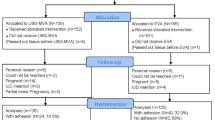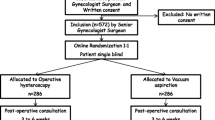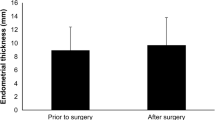Abstract
Purpose
Ultrasound-guided manual vacuum aspiration (USG-MVA) is a feasible and effective outpatient treatment to treat early pregnancy loss.
Methods
This was a prospective observational study at a university-affiliated hospital. All women undergoing either a USG-MVA or electric vacuum aspiration (EVA) were invited to return 3–6 months later for follow-up at which women completed a questionnaire to document their post-evacuation menstrual and reproductive history, and underwent a hysteroscopy if they were not pregnant. The severity of intrauterine adhesion (IUA), if present, was graded (Stage I-III) according to the American fertility society classification.
Results
A total of 292 women had a hysteroscopy after their initial surgical evacuation, USG-MVA 169(57.9%) versus EVA 123(42.1%). Women undergoing EVA as opposed to a USG-MVA had a 12.9% higher incidence of IUA (24.1% vs. 37.0%, p = 0.042) equivalent to 1.84 times higher risk (95% CI 1.01–3.34; p = 0.048). Women having EVA continued to show an increased but not statistically significant trend towards an increased risk of IUA after adjusting for the type of miscarriage (aOR = 1.3; 95% CI 0.66–2.50; p = 0.46).
Conclusion
There were no significant differences in their reproductive outcomes and fewer women post-USG-MVA complained of hypomenorrhea. IUA may still occur in women undergoing USG-MVA but it is lower than the rate in women undergoing EVA.
Clinical trials registry The trial was registered with the Centre for Clinical Research and Biostatistics – Clinical Trials Registry (CCRBCTR), a partner registry of the WHO Primary Registry-Chinese Clinical Trials Registry (ChiCTR) with a Unique Trial Number: CUHK_CCRB00541 on 22 Dec 2016.

Similar content being viewed by others
Data availability
Some or all datasets generated during and/or analyzed during the current study are not publicly available but are available from the corresponding author on reasonable request.
References
Chung JPW, Chung CHS, Mak JSM, Li TC, Kong GWS (2019) Efficacy, feasibility and patient acceptability of ultrasound-guided manual vacuum aspiration for treating early pregnancy loss. Aust New Zeal J Obstet Gynaecol 59:71–76. https://doi.org/10.1111/ajo.12811
Wen J, Cai QY, Deng F, Li YP (2008) Manual versus electric vacuum aspiration for first-trimester abortion: a systematic review. BJOG Int J Obstet Gynaecol 115:5–13. https://doi.org/10.1111/J.1471-0528.2007.01572.X
Tunçalp Ö, Gülmezoglu AM, Souza JP (2010) Surgical procedures for evacuating incomplete miscarriage. Cochrane Database Syst Rev. https://doi.org/10.1002/14651858.CD001993.pub2
Yu D, Wong YM, Cheong Y, Xia E, Li TC (2008) Asherman syndrome—one century later. Fertil Steril 89:759–779. https://doi.org/10.1016/J.FERTNSTERT.2008.02.096
Barash A, Granot I, Fieldust S, Or Y (2009) Successful pregnancy and delivery of a healthy baby after endometrial biopsy treatment in an in vitro fertilization patient with severe Asherman syndrome. Fertil Steril 91:1956.e1-1956.e3. https://doi.org/10.1016/J.FERTNSTERT.2009.01.128
Hooker AB, de Leeuw RA, Twisk JWR, Brölmann HAM, Huirne JAF (2020) Reproductive performance of women with and without intrauterine adhesions following recurrent dilatation and curettage for miscarriage: long-term follow-up of a randomized controlled trial. Hum Reprod. https://doi.org/10.1093/humrep/deaa289
Milingos D, Mathur M, Smith N, Ashok P (2009) Manual vacuum aspiration: a safe alternative for the surgical management of early pregnancy loss. BJOG Int J Obstet Gynaecol 116:1268–1271. https://doi.org/10.1111/j.1471-0528.2009.02223.x
Corcoran A, Hayes-Ryan D, O’Dwyer V, Cooley S, Ramphul M (2023) Audit of Ireland’s first manual vacuum aspiration service. Int J Gynecol Obstet 163:302–306. https://doi.org/10.1002/ijgo.14836
Kakinuma T, Kakinuma K, Sakamoto Y, Kawarai Y, Saito K, Ihara M et al (2020) Safety and efficacy of manual vacuum suction compared with conventional dilatation and sharp curettage and electric vacuum aspiration in surgical treatment of miscarriage: a randomized controlled trial. BMC Pregnancy Childbirth 20:695. https://doi.org/10.1186/s12884-020-03362-4
Chung JPW, Law TSM, Mak JSM, Liu RCY, Sahota DS, Li TC (2022) Hyoscine butylbromide in pain reduction associated with ultrasound-guided manual vacuum aspiration: a randomized placebo-controlled trial. Reprod Biomed Online 44:295. https://doi.org/10.1016/j.rbmo.2021.10.011
Edwards S, Tureck R, Fredrick M, Huang X, Zhang J, Barnhart K (2007) Patient acceptability of manual versus electric vacuum aspiration for early pregnancy loss. J Women’s Heal 16:1429. https://doi.org/10.1089/jwh.2007.0362
Ambreen A, Intsar A (2013) Effectiveness of manual vacuum aspiration in missed miscarriage of less than 12 weeks gestation. J SAFOG 5:154–157. https://doi.org/10.5005/JP-JOURNALS-10006-1250
Choobun T, Khanuengkitkong S, Pinjaroen S (2012) A comparative study of cost of care and duration of management for first-trimester abortion with manual vacuum aspiration (MVA) and sharp curettage. Arch Gynecol Obstet 286:1161–1164. https://doi.org/10.1007/s00404-012-2405-4
Hooker AB, Lemmers M, Thurkow AL, Heymans MW, Opmeer BC, Brölmann HAM et al (2014) Systematic review and meta-analysis of intrauterine adhesions after miscarriage: prevalence, risk factors and long-term reproductive outcome. Hum Reprod Update 20:262. https://doi.org/10.1093/humupd/dmt045
Tam WH, Lau WC, Cheung LP, Yuen PM, Chung TKH (2002) Intrauterine adhesions after conservative and surgical management of spontaneous abortion. J Am Assoc Gynecol Laparosc 9:182–185. https://doi.org/10.1016/S1074-3804(05)60129-6
Dalton VK, Saunders NA, Harris LH, Williams JA, Lebovic DI (2006) Intrauterine adhesions after manual vacuum aspiration for early pregnancy failure. Fertil Steril 85:1823. https://doi.org/10.1016/j.fertnstert.2005.11.065
Okohue JE (2018) Adhesions and abortion. Hysteroscopy. Springer International Publishing, Cham, pp 697–708
Zelivianskaia A, Arcaz A, Kolm P, Robinson JK, Hazen N (2022) Cost-savings analysis of routine hysteroscopy for early detection and treatment of intrauterine adhesions. J Gynecol Surg. https://doi.org/10.1089/gyn.2022.0106
Doubilet PM, Benson CB, Bourne T, Blaivas M (2013) Diagnostic criteria for nonviable pregnancy early in the first trimester. N Engl J Med 369:1443. https://doi.org/10.1056/nejmra1302417
Wie JH, Choe S, Kim SJ, Shin JC, Kwon JY, Park IY (2015) Sonographic parameters for prediction of miscarriage role of 3-dimensional volume measurement. J Ultrasound Med 34:1777. https://doi.org/10.7863/ultra.15.14.09012
Bar-Hava I, Aschkenazi S, Orvieto R, Perri T, Shalev J, Dicker D et al (2001) Spectrum of normal intrauterine cavity sonographic findings after first-trimester abortion. J Ultrasound Med 20:1777. https://doi.org/10.7863/jum.2001.20.12.1277
The American Fertility Society (1988) The American Fertility Society classifications of adnexal adhesions, distal tubal occlusion, tubal occlusion secondary to tubal ligation, tubal pregnancies, Müllerian anomalies and intrauterine adhesions. Fertil Steril 49:944–955. https://doi.org/10.1016/S0015-0282(16)59942-7
Gilman AR, Dewar KM, Rhone SA, Fluker MR (2016) Intrauterine adhesions following miscarriage: look and learn. J Obstet Gynaecol Canada 38:453. https://doi.org/10.1016/j.jogc.2016.03.003
de Godoy C, Cordeiro MRA, Serrano R, de Costa LFF (2005) Prevalence of intrauterine adhesions after manual vacuum aspiration for the tratment of abortion. Rev Bras Ginecol Obs 27:588–593. https://doi.org/10.1590/S0100-72032005001000004
Salzani A, Yela DA, Gabiatti JRE, Bedone AJ, Monteiro IMU (2007) Prevalence of uterine synechia after abortion evacuation curettage. Sao Paulo Med J 125:261–264. https://doi.org/10.1590/S1516-31802007000500002
Lin X-N, Zhou F, Wei M-L, Yang Y, Li Y, Li TC et al (2015) Randomized, controlled trial comparing the efficacy of intrauterine balloon and intrauterine contraceptive device in the prevention of adhesion reformation after hysteroscopic adhesiolysis. Fertil Steril 104:235–240. https://doi.org/10.1016/j.fertnstert.2015.04.008
Al-Inany H (2001) Intrauterine adhesions: an update. Acta Obstet Gynecol Scand 80:986. https://doi.org/10.1034/j.1600-0412.2001.801103.x
Acharya G, Morgan H, Paramanantham L, Fernando R (2004) A randomized controlled trial comparing surgical termination of pregnancy with and without continuous ultrasound guidance. Eur J Obstet Gynecol Reprod Biol 114:69. https://doi.org/10.1016/j.ejogrb.2003.09.042
Chung JPW, Li Y, Law TSM, Ng K, Chau OSY, Choy KW et al (2022) Ultrasound-guided manual vacuum aspiration is an optimal method for obtaining products of conception from early pregnancy loss for cytogenetic testing. Int J Biochem Cell Biol 147:106226. https://doi.org/10.1016/J.BIOCEL.2022.106226
Zheng F, Xin X, He F, Liu J, Cui Y (2020) Meta-analysis on the use of hyaluronic acid gel to prevent intrauterine adhesion after intrauterine operations. Exp Ther Med. https://doi.org/10.3892/etm.2020.8483
Di Spiezio SA, Calagna G, Scognamiglio M, O’Donovan P, Campo R, De Wilde RL (2016) Prevention of intrauterine post-surgical adhesions in hysteroscopy. A systematic review. Eur J Obstet Gynecol Reprod Biol 203:182–192. https://doi.org/10.1016/J.EJOGRB.2016.05.050
Acknowledgements
We would like to thank all the women who have participated in this study as well as Ms. Lee Wing Ki Cheryl and Ms. Chung Mei Lan Tiffany for their assistance in recruiting women and data entry.
Funding
The authors declare that no funds, grants, or other support were received during the preparation of this manuscript.
Author information
Authors and Affiliations
Contributions
JPWC: Conceptualization, Methodology, Investigation, Writing - Original Draft, Supervision, Writing - Review & Editing. OSYC: Investigation, Writing - Original Draft. TSML: Investigation. KN: Investigation. PNPI: Investigation. EYLN: Data Curation, Visualization, Writing - Original Draft. TKYT: Data Curation, Visualization, Writing - Original Draft. DSS: Data Curation, Visualization, Writing - Original Draft. TCL: Supervision, Writing - Review & Editing.
Corresponding author
Ethics declarations
Conflict of interest
The authors have no relevant financial or non-financial interests to disclose.
Consent to participate
Informed consent was obtained from all individual participants included in the study.
Consent for publication
The participant has consented to the submission of the case report to the journal.
Ethical approval
This is an observational study. The study was approved by the Institutional Review Board of our institution (Joint Chinese University of Hong Kong- New Territories East Cluster Clinical Research Ethics Committee registration number CREC-2016.457).
Additional information
Publisher's Note
Springer Nature remains neutral with regard to jurisdictional claims in published maps and institutional affiliations.
Rights and permissions
Springer Nature or its licensor (e.g. a society or other partner) holds exclusive rights to this article under a publishing agreement with the author(s) or other rightsholder(s); author self-archiving of the accepted manuscript version of this article is solely governed by the terms of such publishing agreement and applicable law.
About this article
Cite this article
Chung, J.P.W., Chau, O.S.Y., Law, T.S.M. et al. Incidence of intrauterine adhesion after ultrasound-guided manual vacuum aspiration (USG-MVA) for first-trimester miscarriages: a prospective cohort study. Arch Gynecol Obstet 309, 669–678 (2024). https://doi.org/10.1007/s00404-023-07280-6
Received:
Accepted:
Published:
Issue Date:
DOI: https://doi.org/10.1007/s00404-023-07280-6




